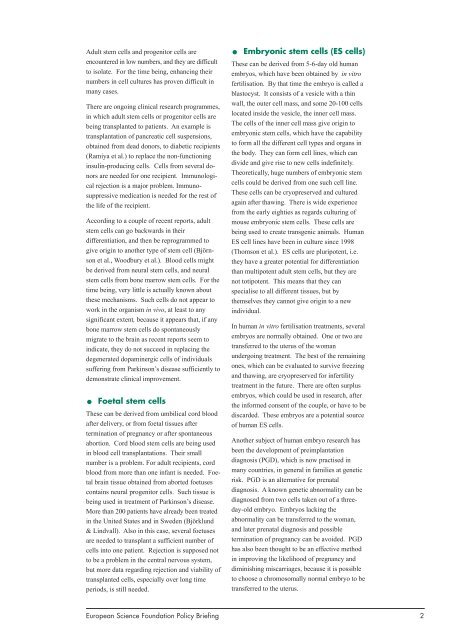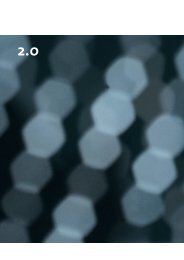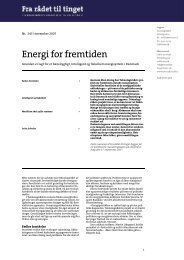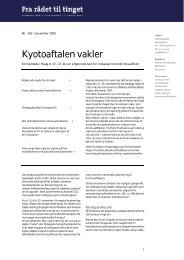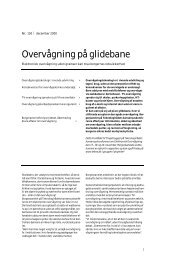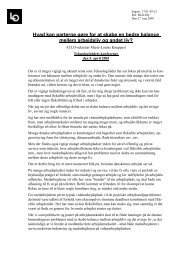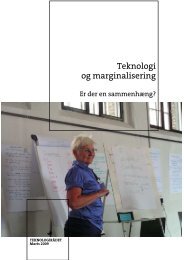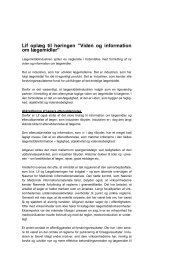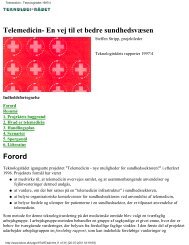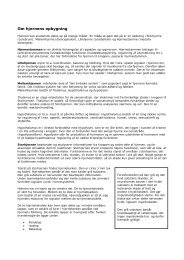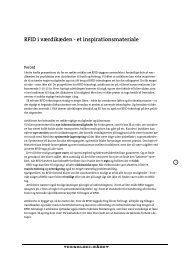Rapport: "Embryonale stamceller". - Teknologirådet
Rapport: "Embryonale stamceller". - Teknologirådet
Rapport: "Embryonale stamceller". - Teknologirådet
You also want an ePaper? Increase the reach of your titles
YUMPU automatically turns print PDFs into web optimized ePapers that Google loves.
Adult stem cells and progenitor cells are<br />
encountered in low numbers, and they are difficult<br />
to isolate. For the time being, enhancing their<br />
numbers in cell cultures has proven difficult in<br />
many cases.<br />
There are ongoing clinical research programmes,<br />
in which adult stem cells or progenitor cells are<br />
being transplanted to patients. An example is<br />
transplantation of pancreatic cell suspensions,<br />
obtained from dead donors, to diabetic recipients<br />
(Ramiya et al.) to replace the non-functioning<br />
insulin-producing cells. Cells from several donors<br />
are needed for one recipient. Immunological<br />
rejection is a major problem. Immunosuppressive<br />
medication is needed for the rest of<br />
the life of the recipient.<br />
According to a couple of recent reports, adult<br />
stem cells can go backwards in their<br />
differentiation, and then be reprogrammed to<br />
give origin to another type of stem cell (Björnson<br />
et al., Woodbury et al.). Blood cells might<br />
be derived from neural stem cells, and neural<br />
stem cells from bone marrow stem cells. For the<br />
time being, very little is actually known about<br />
these mechanisms. Such cells do not appear to<br />
work in the organism in vivo, at least to any<br />
significant extent, because it appears that, if any<br />
bone marrow stem cells do spontaneously<br />
migrate to the brain as recent reports seem to<br />
indicate, they do not succeed in replacing the<br />
degenerated dopaminergic cells of individuals<br />
suffering from Parkinson’s disease sufficiently to<br />
demonstrate clinical improvement.<br />
. Foetal stem cells<br />
These can be derived from umbilical cord blood<br />
after delivery, or from foetal tissues after<br />
termination of pregnancy or after spontaneous<br />
abortion. Cord blood stem cells are being used<br />
in blood cell transplantations. Their small<br />
number is a problem. For adult recipients, cord<br />
blood from more than one infant is needed. Foetal<br />
brain tissue obtained from aborted foetuses<br />
contains neural progenitor cells. Such tissue is<br />
being used in treatment of Parkinson’s disease.<br />
More than 200 patients have already been treated<br />
in the United States and in Sweden (Björklund<br />
& Lindvall). Also in this case, several foetuses<br />
are needed to transplant a sufficient number of<br />
cells into one patient. Rejection is supposed not<br />
to be a problem in the central nervous system,<br />
but more data regarding rejection and viability of<br />
transplanted cells, especially over long time<br />
periods, is still needed.<br />
. Embryonic stem cells (ES cells)<br />
These can be derived from 5-6-day old human<br />
embryos, which have been obtained by in vitro<br />
fertilisation. By that time the embryo is called a<br />
blastocyst. It consists of a vesicle with a thin<br />
wall, the outer cell mass, and some 20-100 cells<br />
located inside the vesicle, the inner cell mass.<br />
The cells of the inner cell mass give origin to<br />
embryonic stem cells, which have the capability<br />
to form all the different cell types and organs in<br />
the body. They can form cell lines, which can<br />
divide and give rise to new cells indefinitely.<br />
Theoretically, huge numbers of embryonic stem<br />
cells could be derived from one such cell line.<br />
These cells can be cryopreserved and cultured<br />
again after thawing. There is wide experience<br />
from the early eighties as regards culturing of<br />
mouse embryonic stem cells. These cells are<br />
being used to create transgenic animals. Human<br />
ES cell lines have been in culture since 1998<br />
(Thomson et al.). ES cells are pluripotent, i.e.<br />
they have a greater potential for differentiation<br />
than multipotent adult stem cells, but they are<br />
not totipotent. This means that they can<br />
specialise to all different tissues, but by<br />
themselves they cannot give origin to a new<br />
individual.<br />
In human in vitro fertilisation treatments, several<br />
embryos are normally obtained. One or two are<br />
transferred to the uterus of the woman<br />
undergoing treatment. The best of the remaining<br />
ones, which can be evaluated to survive freezing<br />
and thawing, are cryopreserved for infertility<br />
treatment in the future. There are often surplus<br />
embryos, which could be used in research, after<br />
the informed consent of the couple, or have to be<br />
discarded. These embryos are a potential source<br />
of human ES cells.<br />
Another subject of human embryo research has<br />
been the development of preimplantation<br />
diagnosis (PGD), which is now practised in<br />
many countries, in general in families at genetic<br />
risk. PGD is an alternative for prenatal<br />
diagnosis. A known genetic abnormality can be<br />
diagnosed from two cells taken out of a threeday-old<br />
embryo. Embryos lacking the<br />
abnormality can be transferred to the woman,<br />
and later prenatal diagnosis and possible<br />
termination of pregnancy can be avoided. PGD<br />
has also been thought to be an effective method<br />
in improving the likelihood of pregnancy and<br />
diminishing miscarriages, because it is possible<br />
to choose a chromosomally normal embryo to be<br />
transferred to the uterus.<br />
European Science Foundation Policy Briefing 2


